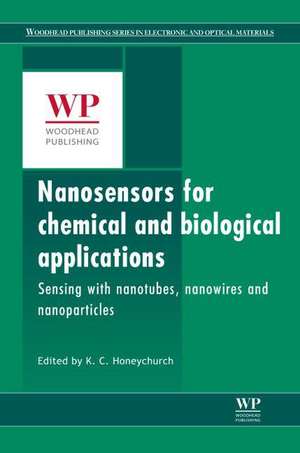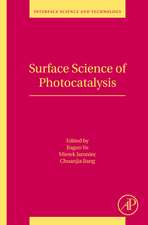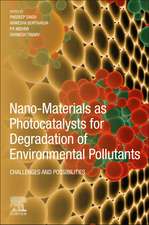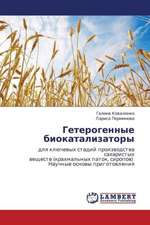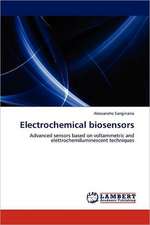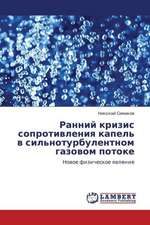Nanosensors for Chemical and Biological Applications: Sensing with Nanotubes, Nanowires and Nanoparticles: Woodhead Publishing Series in Electronic and Optical Materials
Editat de Kevin C. Honeychurchen Limba Engleză Hardback – 11 feb 2014
Part one addresses electrochemical nanosensors and their applications for enhanced biomedical sensing, including blood glucose and trace metal ion analysis. Part two goes on to discuss spectrographic nanosensors, with chapters on the use of nanoparticle sensors for biochemical and environmental sensing and other techniques for detecting nanoparticles in the environment.
Nanosensors for Chemical and Biological Applications serves as a standard reference for R&D managers in a range of industrial sectors, including nanotechnology, electronics, biotechnology, magnetic and optical materials, and sensors technology, as well as researchers and academics with an interest in these fields.
- Reviews the range electrochemical nanosensors, including the use of carbon nanotubes, glucose nanosensors, chemiresistor sensors using metal oxides, and nanoparticles
- Discusses spectrographic nanosensors, such as surface-enhanced Raman scattering (SERS) nanoparticle sensors, the use of coated gold nanoparticles, and semiconductor quantum dots
Din seria Woodhead Publishing Series in Electronic and Optical Materials
- 24%
 Preț: 1160.66 lei
Preț: 1160.66 lei - 18%
 Preț: 1299.95 lei
Preț: 1299.95 lei - 39%
 Preț: 1136.44 lei
Preț: 1136.44 lei - 9%
 Preț: 912.54 lei
Preț: 912.54 lei - 9%
 Preț: 956.68 lei
Preț: 956.68 lei - 24%
 Preț: 951.04 lei
Preț: 951.04 lei - 9%
 Preț: 1335.64 lei
Preț: 1335.64 lei - 29%
 Preț: 986.78 lei
Preț: 986.78 lei - 24%
 Preț: 874.56 lei
Preț: 874.56 lei - 29%
 Preț: 1075.95 lei
Preț: 1075.95 lei - 29%
 Preț: 1414.77 lei
Preț: 1414.77 lei - 9%
 Preț: 1216.61 lei
Preț: 1216.61 lei - 39%
 Preț: 811.62 lei
Preț: 811.62 lei - 29%
 Preț: 1193.77 lei
Preț: 1193.77 lei - 9%
 Preț: 1444.32 lei
Preț: 1444.32 lei - 9%
 Preț: 1107.16 lei
Preț: 1107.16 lei - 9%
 Preț: 1262.45 lei
Preț: 1262.45 lei - 9%
 Preț: 954.69 lei
Preț: 954.69 lei - 9%
 Preț: 1006.73 lei
Preț: 1006.73 lei - 9%
 Preț: 958.65 lei
Preț: 958.65 lei - 9%
 Preț: 948.72 lei
Preț: 948.72 lei - 9%
 Preț: 1150.61 lei
Preț: 1150.61 lei - 23%
 Preț: 1493.72 lei
Preț: 1493.72 lei - 9%
 Preț: 950.94 lei
Preț: 950.94 lei - 24%
 Preț: 1276.29 lei
Preț: 1276.29 lei - 29%
 Preț: 1333.73 lei
Preț: 1333.73 lei - 9%
 Preț: 901.22 lei
Preț: 901.22 lei - 9%
 Preț: 1130.18 lei
Preț: 1130.18 lei - 9%
 Preț: 1049.49 lei
Preț: 1049.49 lei - 24%
 Preț: 871.12 lei
Preț: 871.12 lei - 27%
 Preț: 1459.23 lei
Preț: 1459.23 lei - 20%
 Preț: 1071.49 lei
Preț: 1071.49 lei - 24%
 Preț: 932.11 lei
Preț: 932.11 lei - 29%
 Preț: 1071.64 lei
Preț: 1071.64 lei - 24%
 Preț: 670.36 lei
Preț: 670.36 lei - 9%
 Preț: 926.48 lei
Preț: 926.48 lei - 23%
 Preț: 929.43 lei
Preț: 929.43 lei - 9%
 Preț: 897.50 lei
Preț: 897.50 lei - 9%
 Preț: 1276.81 lei
Preț: 1276.81 lei - 9%
 Preț: 957.63 lei
Preț: 957.63 lei - 29%
 Preț: 845.10 lei
Preț: 845.10 lei - 9%
 Preț: 953.05 lei
Preț: 953.05 lei - 33%
 Preț: 1126.67 lei
Preț: 1126.67 lei - 29%
 Preț: 954.77 lei
Preț: 954.77 lei - 24%
 Preț: 961.16 lei
Preț: 961.16 lei - 23%
 Preț: 930.29 lei
Preț: 930.29 lei - 23%
 Preț: 1080.19 lei
Preț: 1080.19 lei
Preț: 926.89 lei
Preț vechi: 1212.59 lei
-24% Nou
Puncte Express: 1390
Preț estimativ în valută:
177.38€ • 184.51$ • 146.44£
177.38€ • 184.51$ • 146.44£
Carte tipărită la comandă
Livrare economică 05-19 aprilie
Preluare comenzi: 021 569.72.76
Specificații
ISBN-13: 9780857096609
ISBN-10: 0857096605
Pagini: 372
Dimensiuni: 156 x 234 x 35 mm
Editura: ELSEVIER SCIENCE
Seria Woodhead Publishing Series in Electronic and Optical Materials
ISBN-10: 0857096605
Pagini: 372
Dimensiuni: 156 x 234 x 35 mm
Editura: ELSEVIER SCIENCE
Seria Woodhead Publishing Series in Electronic and Optical Materials
Cuprins
Contributor contact details
Woodhead Publishing Series in Electronic and Optical Materials
Introduction
Part I: Electrochemical nanosensors
1. Chemical and biological sensing with carbon nanotubes (CNTs)
Abstract:
1.1 Introduction
1.2 Synthesis of carbon nanotubes (CNTs)
1.3 Functionalization of CNTs
1.4 Biosensors based on multi-walled carbon nanotubes (MWCNTs)
1.5 Technical and industrial challenge for the integration of CNTs in analytical and bioanalytical devices
1.6 Conclusion and future trends
1.7 References
2. Electrochemical nanosensors for blood glucose analysis
Abstract:
2.1 Introduction
2.2 Nanosized materials: enzymatic detection of glucose
2.3 Nanosized materials: direct detection of glucose
2.4 Nanosized sensors
2.5 Conclusion and future trends
2.6 Sources of further information and advice
2.7 References
3. Nanoparticle modified electrodes for trace metal ion analysis
Abstract:
3.1 Introduction
3.2 Nanoparticle modified electrodes: basic principles
3.3 Electroanalytical applications of nanoparticle modified electrodes: detection of arsenic
3.4 Electroanalytical applications of nanoparticle modified electrodes: detection of chromium
3.5 Electroanalytical applications of nanoparticle modified electrodes: detection of lead (II) and cadmium (II)
3.6 Electroanalytical applications of nanoparticle modified electrodes: detection of antimony
3.7 Conclusion
3.8 Sources of further information and advice
3.9 References
4. Interfacing cells with nanostructured electrochemical sensors for enhanced biomedical sensing
Abstract:
4.1 Introduction
4.2 Designing and constructing nanostructured surfaces for cellular sensing
4.3 Electrochemical sensing using nanoelectronic sensing devices
4.4 Interfacing nanostructured sensors for extracellular sensing
4.5 Interfacing amperometric nanostructured sensors with cells for bioelectricity and biomolecule detection
4.6 Interfacing nanostructured sensors for intracellular sensing
4.7 Conclusion
4.8 References
5. Chemiresistor gas sensors using semiconductor metal oxides
Abstract:
5.1 Introduction
5.2 The development of semiconductor metal oxide gas sensors
5.3 The gas-sensing process in semiconductor metal oxide sensors
5.4 Gas sensors using novel low dimensional metal oxides
5.5 Metal oxide nanostructure surface modification and doping
5.6 Recent developments and future trends
5.7 Sources of further information and advice
5.8 References
6. Electropolymers for (nano-)imprinted biomimetic biosensors
Abstract:
6.1 Introduction
6.2 Potential and limitations of molecularly imprinted polymers (MIPs)
6.3 Preparation and performance of molecularly imprinted electropolymers
6.4 Combination of analyte-binding MIPs with nanomaterials
6.5 Integration of analyte recognition with catalysis in MIPs
6.6 Conclusion and future trends
6.7 References
7. Nanostructured conducting polymers for electrochemical sensing and biosensing
Abstract:
7.1 Introduction
7.2 Hard-template synthesis of conducting polymer nanomaterials
7.3 Soft-template synthesis of conducting polymer nanomaterials
7.4 Physical methodologies for synthesis of conducting polymer nanomaterials
7.5 Chemical and biological sensing applications: nanofilms
7.6 Chemical and biological sensing applications: nanoparticle based sensors
7.7 Chemical and biological sensing applications: metallic nanoparticles (NPs), carbon nanotubes (CNTs) and conducting polymer composites
7.8 Chemical and biological sensing applications: nanowires and nanotubes
7.9 Chemical and biological sensing applications: nanofibres, nanocables and other conducting polymer structures
7.10 Conclusion
7.11 References
Part II: Spectrographic nanosensors
8. Surface-enhanced Raman scattering (SERS) nanoparticle sensors for biochemical and environmental sensing
Abstract:
8.1 Introduction: Raman scattering
8.2 Surface-enhanced Raman scattering (SERS)
8.3 SERS-active substrates
8.4 Conclusion
8.6 Acknowledgements
8.5 Sources of further information and advice
8.7 References
9. The use of coated gold nanoparticles in high performance chemical sensors
Abstract:
9.1 Introduction
9.2 Synthesis of gold nanoparticle materials
9.3 Nanoparticle coatings
9.4 Modeling chemical sensing behavior
9.5 Other forms of gold nanoparticle chemical sensors
9.6 Conclusion and future trends
9.7 Sources of further information and advice
9.8 References
10. Nanoporous silicon biochemical sensors
Abstract:
10.1 Introduction
10.2 Synthesis of mesoporous silica materials and enzyme encapsulation
10.3 Application to enzymatic sensor and detection mechanism
10.4 Development of enzymatic sensor for formaldehyde detection
10.5 Conclusion
10.6. References
11. Semiconductor quantum dots in chemical sensors and biosensors
Abstract:
11.1 Introduction
11.2 Quantum dots (QDs): synthesis and optical properties
11.3 Bioconjugation and capping strategies
11.4 Applications of QDs to biosensors
11.5 Conclusion and future trends
11.6 References
12. Nanosensors and other techniques for detecting nanoparticles in the environment
Abstract:
12.1 Introduction
12.2 Overview of nanomaterials
12.3 The regulatory context
12.4 Analytical methodology: measurements of nanoparticles (NPs) in environmental media
12.5 Analytical methodology: detection and size distribution
12.6 Analytical methodology: chemical composition and quantification
12.7 Applications
12.8 Conclusion and future trends
12.9 Sources of further information and advice
12.10 Acknowledgements
12.11 References
Index
Woodhead Publishing Series in Electronic and Optical Materials
Introduction
Part I: Electrochemical nanosensors
1. Chemical and biological sensing with carbon nanotubes (CNTs)
Abstract:
1.1 Introduction
1.2 Synthesis of carbon nanotubes (CNTs)
1.3 Functionalization of CNTs
1.4 Biosensors based on multi-walled carbon nanotubes (MWCNTs)
1.5 Technical and industrial challenge for the integration of CNTs in analytical and bioanalytical devices
1.6 Conclusion and future trends
1.7 References
2. Electrochemical nanosensors for blood glucose analysis
Abstract:
2.1 Introduction
2.2 Nanosized materials: enzymatic detection of glucose
2.3 Nanosized materials: direct detection of glucose
2.4 Nanosized sensors
2.5 Conclusion and future trends
2.6 Sources of further information and advice
2.7 References
3. Nanoparticle modified electrodes for trace metal ion analysis
Abstract:
3.1 Introduction
3.2 Nanoparticle modified electrodes: basic principles
3.3 Electroanalytical applications of nanoparticle modified electrodes: detection of arsenic
3.4 Electroanalytical applications of nanoparticle modified electrodes: detection of chromium
3.5 Electroanalytical applications of nanoparticle modified electrodes: detection of lead (II) and cadmium (II)
3.6 Electroanalytical applications of nanoparticle modified electrodes: detection of antimony
3.7 Conclusion
3.8 Sources of further information and advice
3.9 References
4. Interfacing cells with nanostructured electrochemical sensors for enhanced biomedical sensing
Abstract:
4.1 Introduction
4.2 Designing and constructing nanostructured surfaces for cellular sensing
4.3 Electrochemical sensing using nanoelectronic sensing devices
4.4 Interfacing nanostructured sensors for extracellular sensing
4.5 Interfacing amperometric nanostructured sensors with cells for bioelectricity and biomolecule detection
4.6 Interfacing nanostructured sensors for intracellular sensing
4.7 Conclusion
4.8 References
5. Chemiresistor gas sensors using semiconductor metal oxides
Abstract:
5.1 Introduction
5.2 The development of semiconductor metal oxide gas sensors
5.3 The gas-sensing process in semiconductor metal oxide sensors
5.4 Gas sensors using novel low dimensional metal oxides
5.5 Metal oxide nanostructure surface modification and doping
5.6 Recent developments and future trends
5.7 Sources of further information and advice
5.8 References
6. Electropolymers for (nano-)imprinted biomimetic biosensors
Abstract:
6.1 Introduction
6.2 Potential and limitations of molecularly imprinted polymers (MIPs)
6.3 Preparation and performance of molecularly imprinted electropolymers
6.4 Combination of analyte-binding MIPs with nanomaterials
6.5 Integration of analyte recognition with catalysis in MIPs
6.6 Conclusion and future trends
6.7 References
7. Nanostructured conducting polymers for electrochemical sensing and biosensing
Abstract:
7.1 Introduction
7.2 Hard-template synthesis of conducting polymer nanomaterials
7.3 Soft-template synthesis of conducting polymer nanomaterials
7.4 Physical methodologies for synthesis of conducting polymer nanomaterials
7.5 Chemical and biological sensing applications: nanofilms
7.6 Chemical and biological sensing applications: nanoparticle based sensors
7.7 Chemical and biological sensing applications: metallic nanoparticles (NPs), carbon nanotubes (CNTs) and conducting polymer composites
7.8 Chemical and biological sensing applications: nanowires and nanotubes
7.9 Chemical and biological sensing applications: nanofibres, nanocables and other conducting polymer structures
7.10 Conclusion
7.11 References
Part II: Spectrographic nanosensors
8. Surface-enhanced Raman scattering (SERS) nanoparticle sensors for biochemical and environmental sensing
Abstract:
8.1 Introduction: Raman scattering
8.2 Surface-enhanced Raman scattering (SERS)
8.3 SERS-active substrates
8.4 Conclusion
8.6 Acknowledgements
8.5 Sources of further information and advice
8.7 References
9. The use of coated gold nanoparticles in high performance chemical sensors
Abstract:
9.1 Introduction
9.2 Synthesis of gold nanoparticle materials
9.3 Nanoparticle coatings
9.4 Modeling chemical sensing behavior
9.5 Other forms of gold nanoparticle chemical sensors
9.6 Conclusion and future trends
9.7 Sources of further information and advice
9.8 References
10. Nanoporous silicon biochemical sensors
Abstract:
10.1 Introduction
10.2 Synthesis of mesoporous silica materials and enzyme encapsulation
10.3 Application to enzymatic sensor and detection mechanism
10.4 Development of enzymatic sensor for formaldehyde detection
10.5 Conclusion
10.6. References
11. Semiconductor quantum dots in chemical sensors and biosensors
Abstract:
11.1 Introduction
11.2 Quantum dots (QDs): synthesis and optical properties
11.3 Bioconjugation and capping strategies
11.4 Applications of QDs to biosensors
11.5 Conclusion and future trends
11.6 References
12. Nanosensors and other techniques for detecting nanoparticles in the environment
Abstract:
12.1 Introduction
12.2 Overview of nanomaterials
12.3 The regulatory context
12.4 Analytical methodology: measurements of nanoparticles (NPs) in environmental media
12.5 Analytical methodology: detection and size distribution
12.6 Analytical methodology: chemical composition and quantification
12.7 Applications
12.8 Conclusion and future trends
12.9 Sources of further information and advice
12.10 Acknowledgements
12.11 References
Index
